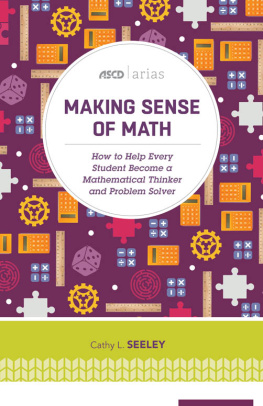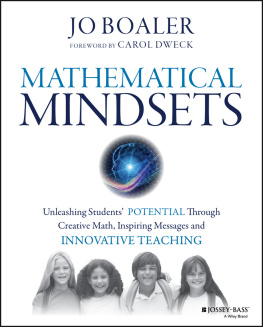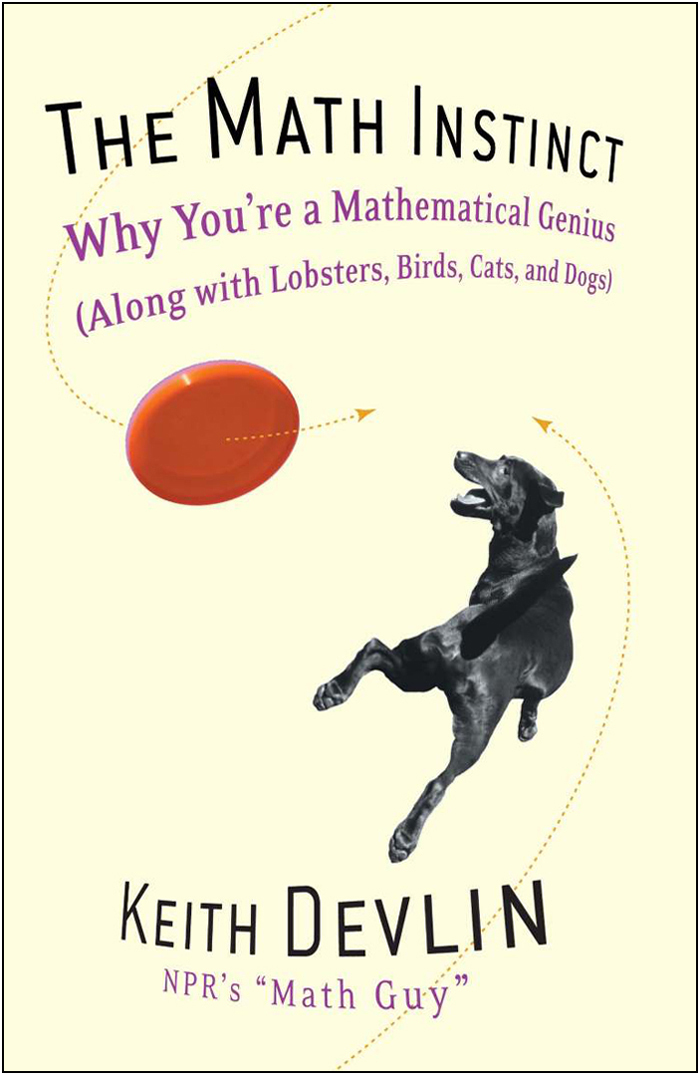

THE MATH INSTINCT
WHY YOURE A MATHEMATICAL GENIUS
(ALONG WITH LOBSTERS, BIRDS, CATS, AND DOGS)
Published by
Thunders Mouth Press
An Imprint of Avalon Publishing Group, Inc.
245 West 17th Street, 11th Floor
New York, NY 10011

Copyright 2005 by Keith Devlin
All rights reserved. No part of this publication may be reproduced or transmitted in any form or by any means, electronic or mechanical, including photocopy, recording, or any information storage and retrieval system now known or to be invented, without permission in writing from the publisher, except by a reviewer who wishes to quote brief passages in connection with a review written for inclusion in a magazine, newspaper, or broadcast.
Library of Congress Cataloging-in-Publication Data is available.
ISBN-13: 978-0-78673-618-8
9 8 7 6 5 4 3 2
Book design by Maria Elias
Distributed by Publishers Group West
Table of Contents
Guide
CONTENTS
M uch of the account of vision in chapter 8 is based on the excellent summary of the human visual system given by Steven Pinker in his book How the Mind Works. Steve kindly gave me permission to use some of the illustrations from his book, and provided me copies of the original Postscript files. Those illustrations were all drawn by Ilavenil Subbiah. For anyone who wants to learn more about vision, I highly recommend Dr. Pinkers treatment of that topic.
[f] were illustrated specifically for this book by Simon Sullivan.
originally accompanied the article Measuring Beelines to Food, published in Science, Vol. 287, Issue 5454, 817818, 4 February 2000, and is reproduced here by courtesy of the articles author, Professor Thomas Collett of the Sussex Centre for Neuroscience at the University of Sussex in England.
originally appeared as Figure 3.6 in Mathematical Biology II, Spatial Models and Biomedical Applications (Springer, New York 2003) by James D. Murray, now Emeritus Professor of Applied Mathematics at the University of Washington, Seattle, who graciously gave his permission to reuse the image here.
accompanied the article How Animals Move: An Integrative View, published in Science, Vol 288, Issue 5463, 100106, 7 April 2000, and are used here courtesy of the articles author, Professor Michael Dickinson of the Department of Bioengineering at Caltech, Pasadena.
appear by courtesy of Professor Denise Schmandt-Besserat of the College of Fine Arts and the Center for Middle Eastern Studies at the University of Texas at Austin.
I would like to thank my agent, Ted Weinstein, for his enthusiasm for this project and the many efforts he put into helping me shape the book into its present form and finding the right publisher. Thanks also to John Oakes of Thunders Mouth Press, who is that right publisher. John wanted this book from the moment he first learned of it, and did everything he could to see it into print.
I n 1992, a young American researcher named Karen Wynn made an announcement that stunned child psychologists all around the world. Wynn claimed to have shown that babies as young as four months old could do simple addition and subtraction problems. In fact, other experimenters subsequently showed that babies can do the same math when they are only two days old!
How had Wynn done it? After all, four-month-old babies cannot yet talk, so how can we possibly discover whether they know that 1 + 1 = 2, to pick one of the examples Wynn claimed her young subjects could do? And how did Wynn manage to pose such a question in the first place so that the children could understand what she was asking?
Before I tell you how Wynn got around these problems, I should make it clear exactly what Wynn claimed to have discovered. First, she did not claim that her subjects had any conscious concept of numbers. As any parent knows, the counting numbers, 1, 2, 3, and so on, have to be taught to young children, and before that can happen the children have to learn how to use language, something that does not happen with a four-month-old baby. Rather, what Wynn claimed was that:
1. The children she examined could tell the difference between a single object, a pair of objects, and a collection of more than two objects.
2. They knew that if you take, say, two single objects and put them together, the resulting collection has exactly two objects in it, not one object and not three.
3. They knew that if you take, say, two objects and remove one of them, you are left with exactly one object; you dont end up with two objects or with none.
The normal way for an adult to describe these abilities would be to say that:
1. The children she examined knew the difference between the numbers 1 and 2 and the difference between 2 and any larger number.
2. They knew that, say, 1 + 1 = 2, and that 1 + 1 is not equal to 1 or 3.
3. They knew that, say, 2 1 = 1, and that 2 1 is not equal to 0 or 2.
Clearly, to express the ability this way requires an understanding of numbers, at the very least the numbers 0, 1, 2, and 3. Now, all the evidence that we have about the way the human brain handles numbers indicates that our ability to handle numbers only comes after the individual learns the numbers words one, two, three, and so on. (Work with chimpanzees and other primates suggests that learning the number symbols 1, 2, 3, work just as well in this regard. The point is that acquisition of the number concept seems to require first having a word or symbol to refer to that concept.)
Strictly speaking, then, Wynns claim was really about numerosity, by which I mean number sense, and especially a sense of the size of a collection, rather than numbers. What she was saying was that very young children have a reliable sense of the size of small collections of objects. But that did not lessen the surprise caused by Wynns announcement. After all, everyone knew that four-month-old babies dont know how to use number words. Most experts assumed that a sense of numerosity developed after the child learned how to count. Wynn was claiming that the number sense comes first. That meant that either we are born with such a sense, or at least we acquire it automatically within at most a few weeks of birth. (As well see below, subsequent research showed that if we are not actually born with a number sense, we acquire it within at most a few days of birth.)
Here is what Wynn did to arrive at her discovery. (Incidentally, Wynns experiment has been repeated successfully many times over by different psychologists around the world, so there is no longer any doubt about the accuracy of her findings.)
The trick was to make use of the fact that even very young babies have acquired a fairly well developed sense of the way things are. If a baby sees something that runs counter to its expectations, it will pay attention to it as it attempts to understand what it sees. By filming the child, particularly its eyes, as it is presented with various scenes, and then measuring the time the baby spends attending to each scene, the investigator can determine what runs counter to the babys expectations. For example, if a baby is shown a series of pieces of fruit on plates, and is then shown an apple suspended in midair with no apparent means of support, the baby will stare measurably longer at the suspended fruit than it does at the fruit on plates.












